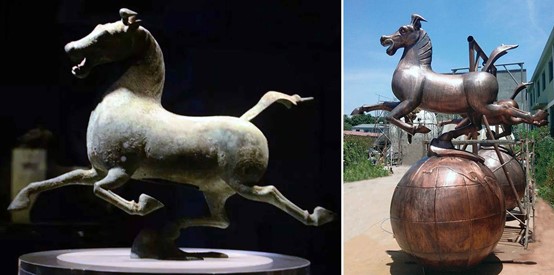During the Qin and Han Dynasties, with the establishment, consolidation and development of a unified centralized feudal country, the country's financial and human resources were highly concentrated, opening up a broad prospect for the prosperity of sculpture art. The rulers of the Qin and Han dynasties regarded sculpture art as a powerful tool to promote the unity of achievements, show the majesty of the royal power, beautify the cemetery buildings, and commemorate the heroes and generals. They made brilliant achievements in ceramic sculpture, stone sculpture, wood sculpture, bronze sculpture, and craft decoration sculpture, and became the first peak in the history of sculpture in China.
Powerful and majestic Terra Cotta Warriors: The main artistic characteristics of this period are that they advocate realism, rigorous techniques, distinctive personality, and vivid images. In the overall layout, the repetition of many upright still bodies has created an overwhelming momentum, which makes people awe and unforgettable.
Concise and vivid pottery figurines of the two Han Dynasty: the Han Dynasty inherited the Qin Dynasty, and the unearthed warrior figurines were vivid in posture, most of them were painted, their shapes were refined, and their looks were powerful. The pottery figurines of maids were fluttering with long sleeves, their dancing steps were light, their posture was very free and easy, and their artistic techniques tended to be simple and general, which was unforgettable.
The profound and magnificent stone carvings of the Han Dynasty: a new achievement in the sculpture art of the Western Han Dynasty, which is highlighted in the large-scale memorial stone carvings, gardens and tomb decoration carvings. Using the artistic technique of stone modeling, the author skillfully integrates the techniques of round carving, relief, line carving and so on. The portrayal of the image is appropriate and sufficient to express the characteristics of the object, and never does too much naturalistic carving, thus strengthening the overall and dynamic sense of the work of art. The stone man, stone beast, and Buddhist carving in the Eastern Han Dynasty have far-reaching influence.
Magnificent and magnificent bronze statues: In the Qin and Han dynasties, bronze statues also had brilliant creations. Their magnificent shape, ingenious design and excellent craftsmanship all exceeded those in the pre-Qin era. Among them, a bronze horse style (commonly known as "horse treads on a flying swallow") was unearthed. The author has unique ingenuity in casting a strong galloping horse, with three feet in the air and one foot on the back of a flying swallow. It has a strong sense of movement, and is known as a wonderful work of bronze sculpture (as shown in the left below). In 1983, the shape of horse treading on a flying swallow was recognized by the National Tourism Administration as a symbol of China's tourism. As shown in the right figure below, the landmark sculpture meticulously created by the remote sculpture factory for the tourist city.

Phone:13451917808 Ms.Sun
Phone:13913853943 Mr.Ma
Tel:025-52607585
Email:yuanfangds@163.com
Add:Guli Industrial Park, Jiangning District, Nanjing City